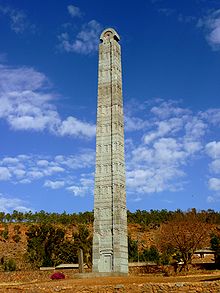Obelisk of Axum
| የአክሱም ሐወልት | |

The Obelisk of Axum in Ethiopia's Tigray Region (2009)
|
|
| Coordinates | 14°7′55.8″N 38°43′10.8″E / 14.132167°N 38.719667°ECoordinates: 14°7′55.8″N 38°43′10.8″E / 14.132167°N 38.719667°E |
|---|---|
| Height | 24.00 m (79 ft) |
The Obelisk of Axum (Amharic: የአክሱም ሐውልት?) is a 1,700-year-old, 24-meter-tall (79-feet) granite stele/obelisk, weighing 160 tonnes, in the city of Axum in Ethiopia. It is ornamented with two false doors at the base and features decorations resembling windows on all sides. The obelisk ends in a semi-circular top part, which used to be enclosed by metal frames.
The obelisk—properly termed a "stele" or, in the local Afro-Asiatic languages, hawelt/hawelti (as it is not topped by a pyramid) — is found along with many other stelae in the city of Axum in modern-day Ethiopia. The stelae were probably carved and erected during the 4th century A.D. by subjects of the Kingdom of Aksum, an ancient Ethiopian civilization. Erection of stelae in Axum was a very old practice (today it is still possible to see primitive roughly carved stelae near more elaborated "obelisks"), probably borrowed from the Kushitic kingdom of Meroe. Their function is supposed to be that of "markers" for underground burial chambers. The largest of the grave markers were for royal burial chambers and were decorated with multi-story false windows and false doors, while lesser nobility would have smaller, less decorated ones. While there are only a few large ones standing, there are hundreds of smaller ones in various "stelae fields". The last stele erected in Axum was probably the so-called King Ezana's Stele, in the 4th century A.D.
King Ezana (c.321 – c. 360), influenced by his childhood tutor Frumentius, introduced Christianity to Axum, precluding the pagan practice of erecting burial stelae (it seems that at the feet of each obelisk, together with the grave, there was also a sacrificial altar).
...
Wikipedia
